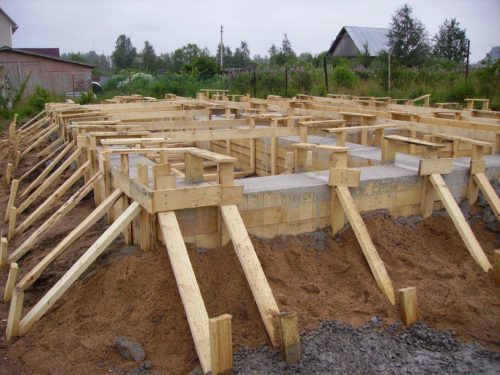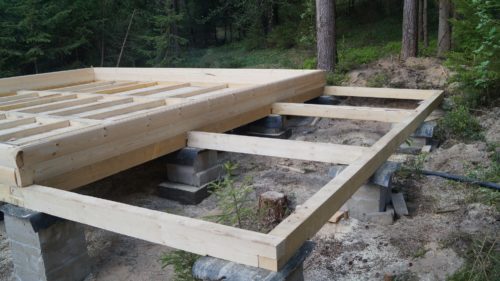At the beginning of construction work, the most responsible is the characteristic of the soil, on the basis of which all actions occur. Unfortunately, there are many examples of situations in which the problem soil was the main reason for the impossibility of building events. First of all, we are talking about security issues, since certain soils or terrain can create a serious danger of both building design and people living in this territory. It is important to remember that the very details related to the safety of the design should be based on long-term exploitation, but the soils can easily turn it all.
Content
But at the same time, it should be borne in mind that those or other types of foundations can be used for various soils, which are better suitable for long-term operation. In this case, we will talk about sandy soil, which has a number of interesting features related to the construction of structures. In this material, we will consider the specifics of using a screw foundation, as well as some other interesting details.
Features of sandy soil when creating a foundation
According to experts, fine-grained sand is a rather large-scale problem at any construction events. Extremely simple deformation of this foundation creates certain difficulties in the operation of building structures of various scales. At the same time, coarse-grained sand is a good basis, which takes good water, is not frosty, and is also distinguished by resistance to seasonal changes.
However, in both cases there are certain problems with the scale of construction. It is known that too large building structures are not desirable to build on the sandy soil, since after a short period of time the construction may be under a serious threat. It may be the appearance of cracks throughout the construction object, or some deformations.
According to professionals, the main problem when using sandy soils as a basis for construction is the possibility of formation of floats in those areas where groundwater is closely located.
Well, the most important thing is that on a fairly specific basis, it is best to implement small construction projects that are not able to create too many negative consequences in the presence of problems.
At the same time, experts focus on the fact that the difficulties associated with the soil can be quickly corrected quite quickly, however, the cost of such events is often too high to think seriously about it.
Foundation on sandy soil. Using a column foundation
The foundation based on small pillars is a good solution for those who carry out construction measures based on coarse sand. Practice shows that such a foundation is capable of listening to many years, but only if the soil does not hide some other problem points in themselves.
- First of all, the site on which the foundation will be erected is completely cleaned. It should be a flat place, and to clearly enter the framework of the site. You can use pegs, between which the rope is stretched. As a result, the pillars used to create a foundation should be located at the corners of the structure, as well as at the intersection of bearing walls. Additional reference elements can be installed, however, in the case of a small construction object, there is simply no such need.
- Poles themselves are support blocks that are usually created based on concrete elements or bricks. Directly under the reference elements themselves, a recess is created up to 40 cm. Also creates a cushion from rubble, which eliminates the possibility of the moisture of moisture from the soil. However, the waterproofing layer should be put on crushed stone, which should demonstrate a good effect.
- The dimensions of the posts must correspond to the location of their location. For example, at the corners of the foundation, the reference parts should consist of more blocks or brick rows than in other places.
- On top of the poles are stacked elements that will be in direct contact with the house. Often these are wood beams whose fastening can occur the most diverse ways. Next occurs directly the construction of the walls of the dwelling.
Sail-ribbon foundation on dust sand
Dusty sand creates the most problems if it comes to creating a fairly overall structure. Piles in any construction project mean soil strengthening, especially if this soil has certain problems.
- Initially, the fertile layer of soil is removed, most often it is a small depth. The creation of a pit here is quite specific, since the sandy soil will definitely occur. It is advisable to carry out these works in such a way that the walls of the pita were at an angle of 45 degrees.
- The formwork of the foundation consists of wood shields that are enhanced by pins and tie. Well, the most important thing is to create wells, which are located at the corners of the structure, as well as every 2 meters around the perimeter of the future foundation. As for the depth of drilling, everything is limited exclusively by the location of stable soils. It can be both 50 cm and a few meters.
- If floating is found, the piles are performed from asbestos-cement pipes. Directly the pipes themselves are located in wells. A lot of time is paid to align these elements in terms of level, thanks to which the foundation is distinguished by proper geometry.
- Next follows the pouring piles concrete. To do this, it will be necessary to simply deliver the required volume of the mixture on the site, and then start its supply to the well. It should be stopped after filling 1/3 of part of the volume, after which it is a bit lumping the pipe so that the concrete mixture is spread in the best way. As a result, at the bottom of the well, we have a deepening, which only positively affect the strength of the structure. Also in the well inserted fittings (only about 3-4 rods). They need to be combined with a wire or some other means. After using the well reinforcement is filled with concrete to the very end.
- Now the trendy sand is falling asleep with the sand of a large fraction. In addition, waterproofing is used. Again, the reinforcement will be required, which is made of corrugated rod. You need to realize 2 belts - from below. The mating vertical and horizontal components is performed using a wire. It is undesirable to use welding in this matter, since in places of welding can start its "black" case corrosion.
- Next follows another fill with concrete, already final. We need to fill the same trenches that are equipped with formwork. Fill must be done either for one approach or layers. After the fill, the concrete is aligned, well, and at the end all this is covered with a film to protect the future foundation from atmospheric cages.
- Already after pouring the concrete, it is necessary to produce vertical waterproofing of the structure. This will allow to protect the foundation of the house from tangent loads. When it comes to sections with wet soils, there is a need for drainage.
Screw foundation
Obviously, the screw foundation cannot be called the most durable and durable, so it fits most of all for small structures, or those that do not have too large mass.
The advantages of the screw foundation:
- There is no need for complex earthworks. The main stage of the work of the foundation is the screwing of metal elements in the ground. Accordingly, earthworks here practically should not be.
- Work at any time of the year. Creating a screw foundation can be carried out practically at any time of year, exception can only be extreme frosts.
- Versatility. Specialists argue that the screw foundation shows well in virtually any terrain.
Disadvantages are also present, and they can significantly affect the opinions of the owners:
- Select piles. Unfortunately, the unprofessional pick up the most optimal on a variety of pile characteristics is not easy. It is necessary to take into account the depth of the freezing, the general characteristics of the soil, the dimensions of the future structures and much more.
- Problems when screwing the piles. Trees, shrubs and other plants may be much hammering the screwing of piles, so you need to take care of all the planned events threatening in advance. In addition, the soil may be problematic, and the use of piles can be something difficult.
- Invisible performers. Often, screw piles are screwed by specialists who in a hurry provide not the highest quality of their work. Accordingly, even a small violation of technology can lead to serious consequences.
Creation of screw foundation:
- First you need to create a markup of the site. There should be a plan for which construction measures will occur. The site is aligned and cleaned from the garbage and the necessary objects.
- Initially, according to plan or documentation, which specialists are developing, the depth of the layout of the piles, as well as the dimensions of these metal elements should be known.
- Well, after all the above actions, the main part of the work occurs. The screwing of the piles is better to carry out special equipment, as it is necessary to do everything quickly and efficiently - it will not work. Piles are exhibited at one level.
- The top of the pile is the basis for supplementing the foundation of a sustainable basis. It can be wood or concrete elements, but most often found the first. A small test for durability still should take place, as the soil suddenly can show itself not from the best side.
Here I would also like to say that the choice of foundation on the sandy soil primarily depends precisely from the site, since the screw piles may not be better than a number of reasons voiced earlier. Therefore, you should always consult with specialists, as this business is too responsible to accept not the surest solutions.
























Many owners of private houses, summer residents and gardeners face the problem of soil moistening. In the spring, in the period of melting of snow, as well as after heavy rains in the yard near the house there may be large puddles, there is a smell of dampness in the house, mold is formed in the basement.
The source of such problems is a bad drainage system that does not cope with water flows on the plot due to the features of its relief and soil. Water harms not only buildings on the site, but also of all vegetation. Therefore, it is necessary to deal with the problem, and the specialists of the company "Dachnaya Uyut Plus" are taken to help you.
Everything will make it quickly and efficiently!
https: //xn--80ahqp0afz7a3a.xn--p1ai/inzhenernye-sistemy-ograzhdeniya/ustrojstvo-drenazha/ustrojstvo-drenazha-doma-fundamenta-doma-i-uchastka/